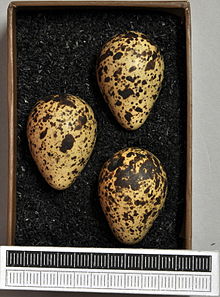Odin's chicken
| Odin's chicken | ||||||||||
|---|---|---|---|---|---|---|---|---|---|---|

Female of the Odin chickens in breeding dress |
||||||||||
| Systematics | ||||||||||
|
||||||||||
| Scientific name | ||||||||||
| Phalaropus lobatus | ||||||||||
| ( Linnaeus , 1758) |
The Odin's chicken ( Phalaropus lobatus ) is a species from the genus of the water treaders . It is one of the Arctic snipe birds and can occasionally be observed on the German North Sea coast during its migration period in August and September as well as April and May .
The German common name is derived from the Nordic god Odin .
Appearance
Brood plumage
The Odins Chicken is characterized by an unmistakable breeding dress. Its upper side is slate-gray in the female and gray-brown in the male. The underside and throat are white. Noticeable is a spot on the fore neck that reaches up to the cheeks and is orange-red in the female and orange-brown in the male and is smaller. In the breeding dress, the Odin's chick can be clearly distinguished from the Thor's chick , which is the second species in the genus of the water treaders according to common understanding today. The Wilson's treadmill , which was formerly also assigned to this genus, is now usually the only species in the genus Steganopus .
Resting dress
After moulting in the period from August to December, the Odin's chicken changes to the resting dress in which the sexes can no longer be distinguished. The differences to the Thoroughbred are now less obvious. When resting, the lower body is colored white; in the case of the Odin's chickens the white ends on the top of the head before the parting line. The back is light gray, but darker than that of the Thor's chickens.
distribution
The distribution of the Odin's chick is nowhere near as high Arctic as that of the Thor's chick. Breeding occurrences can also be found on Iceland , the Faroe Islands , the Shetland Islands , the Orkneys and the Hebrides as well as on mainland Norway , Sweden and Finland . The Odins chick breeds far inland and not necessarily as close to the coast as the Thor's chickens. The winter quarters are scattered across tropical and subtropical seas, but also on the coasts of Patagonia and southern Japan . You can see it again and again on its trains at Lake Neusiedl.
Way of life
The Odin's chicken is characterized by a way of life that is unusual for birds. The female actively chooses the partner and woos him in a conspicuous courtship flight. The males also lead the young birds. This behavior is also typical of the Thoroughbred. The reproduction and the form of food acquisition is therefore described in detail in the main article Water Treaders (Birds) .
Duration
The European breeding population is estimated at 85,000 to 220,000 breeding pairs at the beginning of the 21st century. Countries with more than 10,000 breeding pairs include Russia, Greenland, Iceland, Finland, Norway and Sweden.
Like many other snipe birds, the Odin's chick is one of the species that will be particularly affected by climate change. A research team that, on behalf of the British Environmental Protection Agency and the Royal Society for the Protection of Birds, examined the future development of the distribution of European breeding birds on the basis of climate models, assumes that by the end of the 21st century the range of the Odin's chickens will decrease by almost two thirds will shrink and shift to the northeast. According to these forecasts, new potential distribution areas arise on Svalbard and Novaya Zemlya, but they cannot compensate for the loss of area in Iceland, Finland and in the south of Norway.
supporting documents
literature
- Hans-Günther Bauer, Einhard Bezzel and Wolfgang Fiedler (eds.): The compendium of birds in Central Europe: Everything about biology, endangerment and protection. Volume 1: Nonpasseriformes - non-sparrow birds. Aula-Verlag Wiebelsheim, Wiesbaden 2005, ISBN 3-89104-647-2 .
- Otto Höhn: The water treaders (Phalaropodidae). Ziemsen, Wittenberg 1965, ISBN 3-89432-753-7 .
- Josep del Hoyo et al .: Handbook of the Birds of the World. Volume 3: Hoatzin to Auks. Lynx Edicions, 1996, ISBN 84-87334-20-2 .
- Bernhard Grzimek: Grzimeks Tierleben , Volume 8 ( Birds 2 ). Kindler, 1969, ISBN 3-8289-1603-1 .
- Stanley Cramp , David Snow : The Complete Birds of the Western Palearctic. Oxford University Press, 1998, ISBN 0-19-268579-1 .
Web links
- Phalaropus lobatus in the endangered Red List species the IUCN 2008. Posted by: BirdLife International, 2008. Accessed January 31 of 2009.
- Videos, photos and sound recordings of Phalaropus lobatus in the Internet Bird Collection
- taz article: Ode to the Chicken Odins, February 10, 2007
- Single receipts
- ↑ Bauer et al., P. 489
- ^ Brian Huntley, Rhys E. Green, Yvonne C. Collingham, Stephen G. Willis: A Climatic Atlas of European Breeding Birds , Durham University, The RSPB and Lynx Editions, Barcelona 2007, ISBN 978-84-96553-14-9 , P. 204

